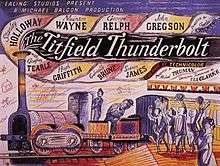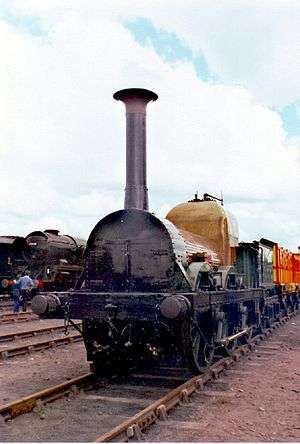The Titfield Thunderbolt
| The Titfield Thunderbolt | |
|---|---|
 Theatrical release poster | |
| Directed by | Charles Crichton |
| Produced by | Michael Truman |
| Written by | T.E.B. Clarke |
| Starring |
Stanley Holloway George Relph Naunton Wayne John Gregson Hugh Griffith Gabrielle Brune Sid James |
| Music by | Georges Auric |
| Cinematography | Douglas Slocombe |
| Edited by | Seth Holt |
| Distributed by |
General Film Distributors (UK) Universal-International (USA) |
Release dates | March 1953 |
Running time | 84 minutes |
| Country | United Kingdom |
| Language | English |
The Titfield Thunderbolt is a 1953 British comedy film about a group of villagers trying to keep their branch line operating after British Railways decided to close it. The film was written by T.E.B. Clarke and was inspired by the restoration of the narrow gauge Talyllyn Railway in Wales, the world's first heritage railway run by volunteers.
It starred Stanley Holloway, George Relph and John Gregson, and was directed by Charles Crichton. Michael Truman was the producer. The film was produced by Ealing Studios. It was the first Ealing comedy shot in Technicolor and one of the first colour comedies made in the UK.
There was considerable inspiration from the book Railway Adventure by established railway book author L. T. C. Rolt, published in 1952. Rolt had acted as honorary manager for the volunteer enthusiasts running the Talyllyn Railway for the two years 1951-52. A number of scenes in the film, such as the emergency re-supply of water to the locomotive by buckets from an adjacent stream, or passengers being asked to assist in pushing the carriages, were taken from this book.
Plot
The residents of the village of Titfield rely on the railway branch line to commute to work and transport their produce to market, so they are shocked when the government announces that the line is to be closed. The local vicar, railway enthusiast Sam Weech (George Relph), suggests that it should be run locally. He and the village squire, Gordon Chesterford (John Gregson), persuade wealthy Walter Valentine (Stanley Holloway) to provide the financial backing by telling him they can legally operate a bar while the train is running, so he will not have to wait for the local pub to open.
They are bitterly opposed by bus operators Alec Pearce (Ewan Roberts) and Vernon Crump (Jack MacGowran), but the line's supporters persuade the Ministry of Transport to grant them a month's trial period with an inspection at the end. Dan Taylor (Hugh Griffith), a retired track layer, knows how to run an engine and joins the venture. On the maiden run, Crump and Pearce try to block a crossing, first with their lorry and then with a passing steam roller operated by Harry Hawkins (Sid James), but the steam locomotive is too powerful and pushes them off the track.
The next day, Crump and Pearce persuade an irate Hawkins to shoot holes in the water tower, but the passengers form a bucket brigade and refill the engine from a nearby river. The night before the inspection, Hawkins, Crump and Pearce sabotage the line by using the steamroller to tow the unguarded engine and coach down the gradient, where it runs off the track. The village solicitor, Blakeworth, is mistakenly blamed and arrested.
Taylor and Valentine get drunk together and borrow an engine from the Mallingford yards but, after mistakenly driving it along the town's main street and running it into a large oak tree, they are arrested. Now with no usable engine, Weech decides to get the antique Thunderbolt from the museum. They also commandeer Dan Taylor's home, an old railway carriage body, which is hastily strapped to a flat wagon. The impromptu train is completed by a brake van for the guard to use.
With Taylor's arrest, Weech is left without a fireman. Fortunately, Weech's friend and fellow railway devotee, Ollie Matthews (Godfrey Tearle), the Bishop of Welchester, comes to visit and willingly steps in to lend a hand. Meanwhile, Pierce and Crump see Thunderbolt from the road and, distracted, run their bus into the police van carrying Taylor and Valentine to gaol. Pierce panics and confesses to the train wrecking, and the two are also arrested.
As the train is about to start its run, the police demand to be carried to Mallingford with their four prisoners. The Ministry inspector (John Rudling) refuses to adjust the starting time for the delay. Weech and Chesterford had improvised a means of connecting the engine to the rest of the train using a length of rope, but during a braking test down the line, the rope snaps. The Thunderbolt leaves the rest of the train behind, but several villagers manage to quietly push the carriages to meet up again with the engine at the water tower, with the inspector none the wiser. Then Joan Hampton (Gabrielle Brune) promises to marry Hawkins to get him to lend them the chain from his roller's steering mechanism to replace the broken rope.
After so many delays, the train pulls into Mallingford station nearly ten minutes late. The villagers think that this will prove their downfall, but it turns out that if they had been faster, they would have exceeded the speed limit for light railways. Instead, the line passes inspection, clearing the way for the Light Railway Order to be made permanent.
Cast
- Stanley Holloway as Walter Valentine
- George Relph as Vicar Sam Weech
- Naunton Wayne as George Blakeworth
- John Gregson as Squire Gordon Chesterford
- Godfrey Tearle as Ollie Matthews, the Bishop of Welchester
- Hugh Griffith as Dan Taylor
- Gabrielle Brune as Joan Hampton
- Sid James as Harry Hawkins
- Reginald Beckwith as Coggett
- Edie Martin as Emily
- Michael Trubshawe as Ruddock
- Jack MacGowran as Vernon Crump
- Ewan Roberts as Alec Pearce
- Herbert C. Walton as Seth
- John Rudling as Clegg
- Nancy O'Neil as Mrs. Blakeworth
- Campbell Singer as Police Sergeant
- Frank Atkinson as Station Sergeant
- Wensley Pithey as Policeman
Driver Ted Burbidge, fireman Frank Green and guard Harold Alford were not actors: they were British Railways employees from the Westbury depot, provided to operate the train on location. Charles Crichton spoke with them on location and realised they "looked and sounded the part", so they were given speaking roles and duly credited.
GWR 1400 Class 0-4-2T locomotive number 1401 was a real locomotive and hired by the producers.
Production

Shooting was largely carried out near Bath, Somerset, on the Camerton branch of the Bristol and North Somerset Railway, along the Cam Brook valley between Camerton and Limpley Stoke. The branch had closed to all traffic on 15 February 1951, but was reopened for filming. Titfield railway station was in reality Monkton Combe railway station, whilst Titfield village was nearby Freshford, with other scenes being shot at the disused Dunkerton Colliery. Mallingford railway station in the closing scene was Bristol Temple Meads railway station. The opening scene shows Midford Viaduct on the Somerset and Dorset Joint Railway, where the branch passed under the viaduct. The scene featuring Sid James' character's traction engine, and the Squire's attempts to overtake it, was filmed in Carlingcott.
The scene, where a replacement locomotive is 'stolen' was filmed in the Oxfordshire town of Woodstock. The 'locomotive' was a wooden mock-up mounted on a lorry chassis; the rubber tyres can (just) be spotted sitting inside the driving wheels. The earlier scene of No. 1401 crashing and getting wrecked as it heads down an embankment used highly effective scale models.
The Thunderbolt itself was played by an actual antique museum resident, the Liverpool and Manchester Railway locomotive Lion, built in 1838 and so at the time 114 years old. Lion is one of the earliest British locomotives, only nine years younger than Stephenson's Rocket, and really under steam in the film. It was repainted in a colourful red and green livery to suit the Technicolor cameras. In filming the scene in which the Thunderbolt is "rear-ended" by the uncoupled train, the locomotive's tender sustained some actual damage, which remains visible beneath the buffer beam to this day. The scene where Thunderbolt is removed at night from its museum was filmed in the (now demolished) Imperial Institute building near the Royal Albert Hall in South Kensington, London. All these shots were made using a studio-built model.
The steam roller used was a 1904 Aveling & Porter 5 n.h.p. 10 ton Type R10 Steam Road Roller named Maid Marion, registration number CH3282, (works number 5590).[1] It was still in commercial service at the time of filming. It was eventually sold for preservation and after a full restoration, the roller returned to steam in 2006. It was in action as part of the road-making demonstration at the Great Dorset Steam Fair that year.
Reception
The film was well received by critics upon its original release.
Home media
It was released first on VHS in 1993, and then on DVD in 2004.
A release on Blu-ray in 2013 followed the restoration of the film.
Trivia
- T.E.B. Clarke was a neighbour in East Grinstead of Richard Beeching, then Director of ICI, at the time of writing and filming. Beeching's 1963 report The Re-shaping of British Railways resulted in the closure of many branch lines like the one portrayed in the film. Beeching also wrote some technical dialogue for The Man in the White Suit, another of Clarke's films.
- The name "Titfield" is an amalgamation of the villages of Limpsfield and Titsey in Surrey, near Clarke's home at Oxted.[2]
References
- ↑ 1904 Aveling & Porter IMDB Car Database, 2006
- ↑ Simon Castens (February 2011). "The Titfield Thunderbolt and the Camerton Branch" (PDF). Address to Wells Railway Fraternity.
Further reading
- Fosker, Oliver (1 November 2008). The Titfield Thunderbolt ~ Now & Then. Up Main Publishing. ISBN 978-0-9561041-0-6.
- Castens, Simon (22 July 2002). On the Trail of The Titfield Thunderbolt. Thunderbolt Books. ISBN 0-9538771-0-8.
- Huntley, John (1969). Railways in the Cinema. Ian Allan. pp. 76–79. ISBN 0-7110-0115-4.
- Mitchell, Vic; Keith Smith (June 1996). Frome to Bristol including the Camerton Branch and the "Titfield Thunderbolt". Middleton Press. ISBN 1-873793-77-4.
External links
- The Titfield Thunderbolt at the Internet Movie Database
- The Titfield Thunderbolt Filming Locations
- http://www.lionlocomotive.org.uk/ LION, an interesting 'Old Locomotive', probably best known as taking a starring part in the film 'Titfield Thunderbolt'